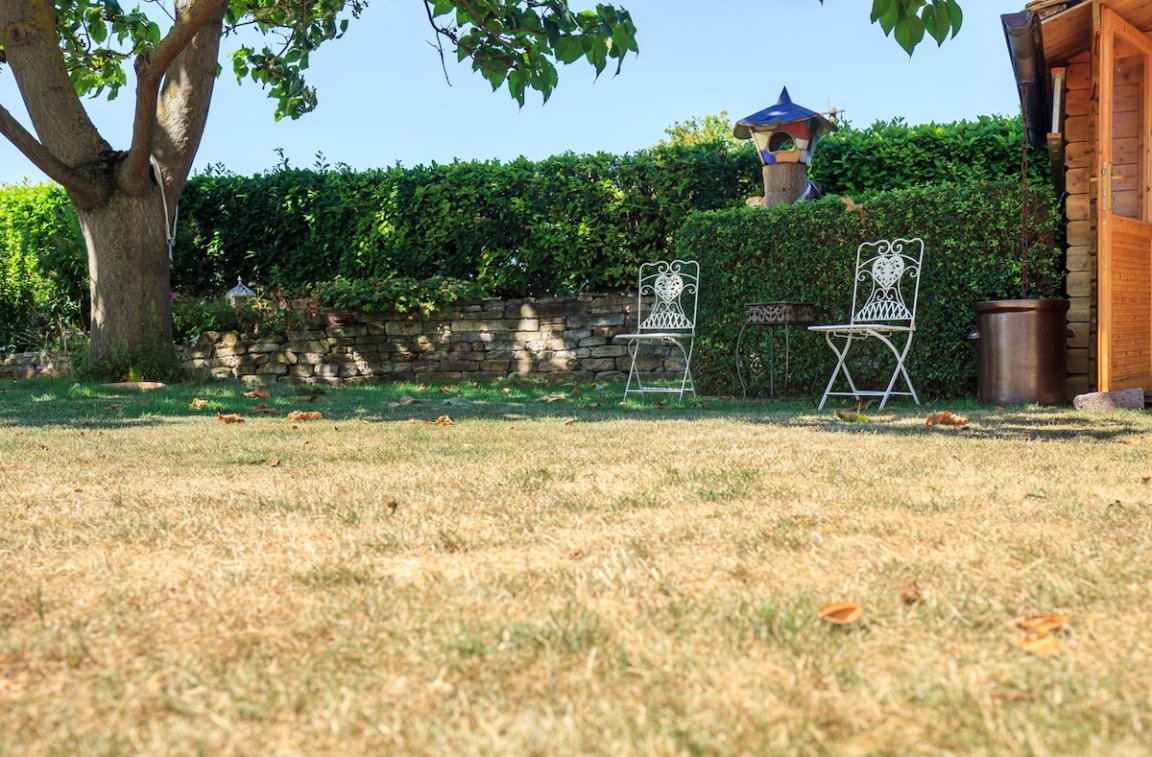We may earn revenue from the products available on this page and participate in affiliate programs. Learn More ›
We may earn revenue from the products available on this page and participate in affiliate programs. Learn More ›
Today’s warmer temps mean that turfgrass planted 20 or more years ago may be struggling to adapt to our changing world. Global temperatures have risen 0.36 degrees Fahrenheit every decade since 1983, according to Climate.gov, a website of the National Oceanic and Atmospheric Administration (NOAA). The agency adds, “The 10 warmest years in the historical record have all occurred in the past decade (2014-2023).”
As Earth warms and water becomes more scarce, grasses that require high levels of moisture may fail to flourish when drought conditions persist. Rainfall may be limited, and local watering restrictions may prevent supplemental irrigation. Fortunately, there are plenty of drought-tolerant turfgrasses that can survive and even retain their green good looks during a dry spell, thanks to grass characteristics such as low water requirements, efficient root systems, above- or below-ground stems that repair bare or damaged grass patches, and the ability to go dormant and recover when water is restored. The other good news is there are steps you can take to improve a lawn’s resistance to drought. For instance, Sal Musto, founder of SalCorp Landscaping & Construction in Walpole, Massachusetts, advises that “adding organic matter such as compost can significantly increase the soil’s moisture retention.” Read on for more tips to improve an existing lawn and to learn the best drought-resistant grass to plant for a verdant dry-season turf.
Choose a grass that thrives in your climate.
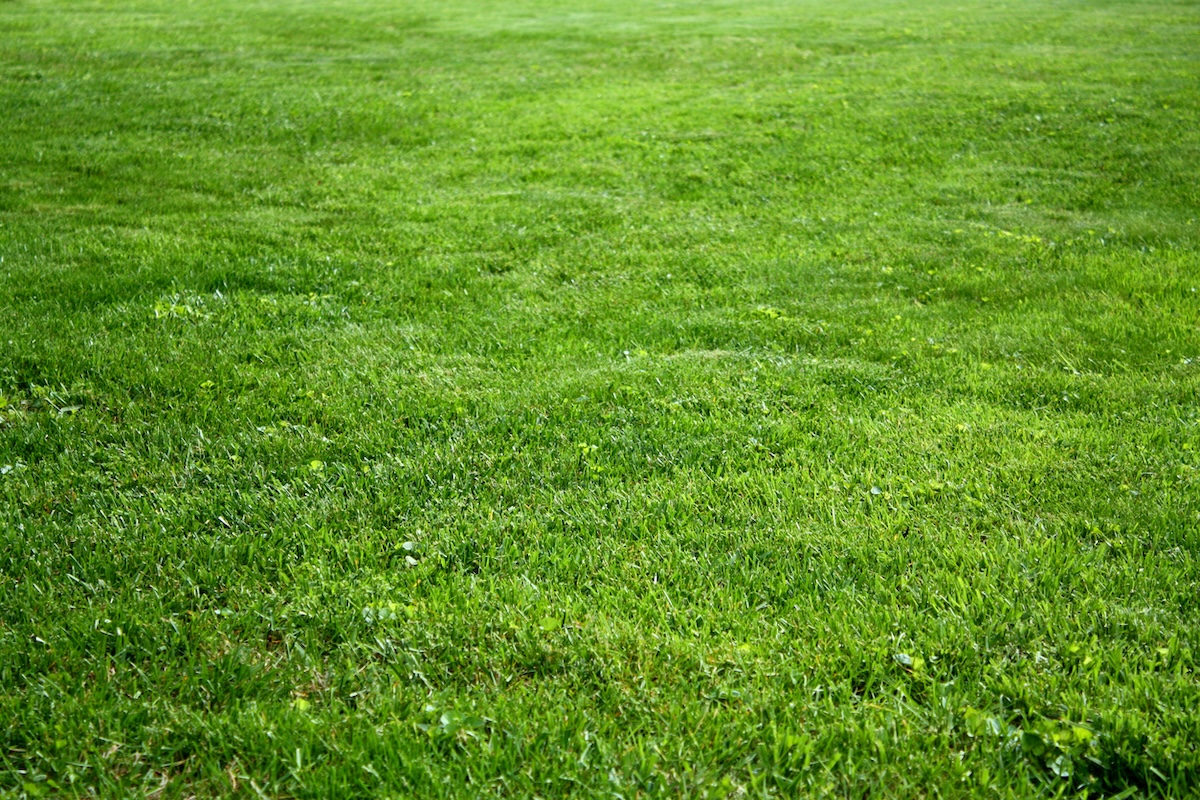
Like all turfgrasses, drought-resistant grasses fall into two categories: warm-season or cool-season. “Cool-season areas have cold winters and mild summers, while warm-season areas have hot summers and mild winters,” says Marek Bowers, a sustainable landscaper in Southern California and founder of the drought-tolerant plants and gardening website Bolder Green.
It’s important to choose the right grass for your climate zone to ensure it will grow well in the temperatures in your area.
- Warm-season grasses grow best in regions with hot summers and milder winters, such as the Deep South and the Southeast.
- Cool-season grasses thrive in places with temperate summers and many below-freezing winter days, including Northern California, the Pacific Northwest, the Upper Great Plains, the Upper Midwest, and New England.
- Take your pick of cool-season or warm-season grasses if you live in the “transition zone” between the north and south (e.g., from Southern California going east to the Virginias), where both types of grasses grow well.
The best drought-resistant grasses for warm-season climates include Bermuda, zoysia, and St. Augustine.
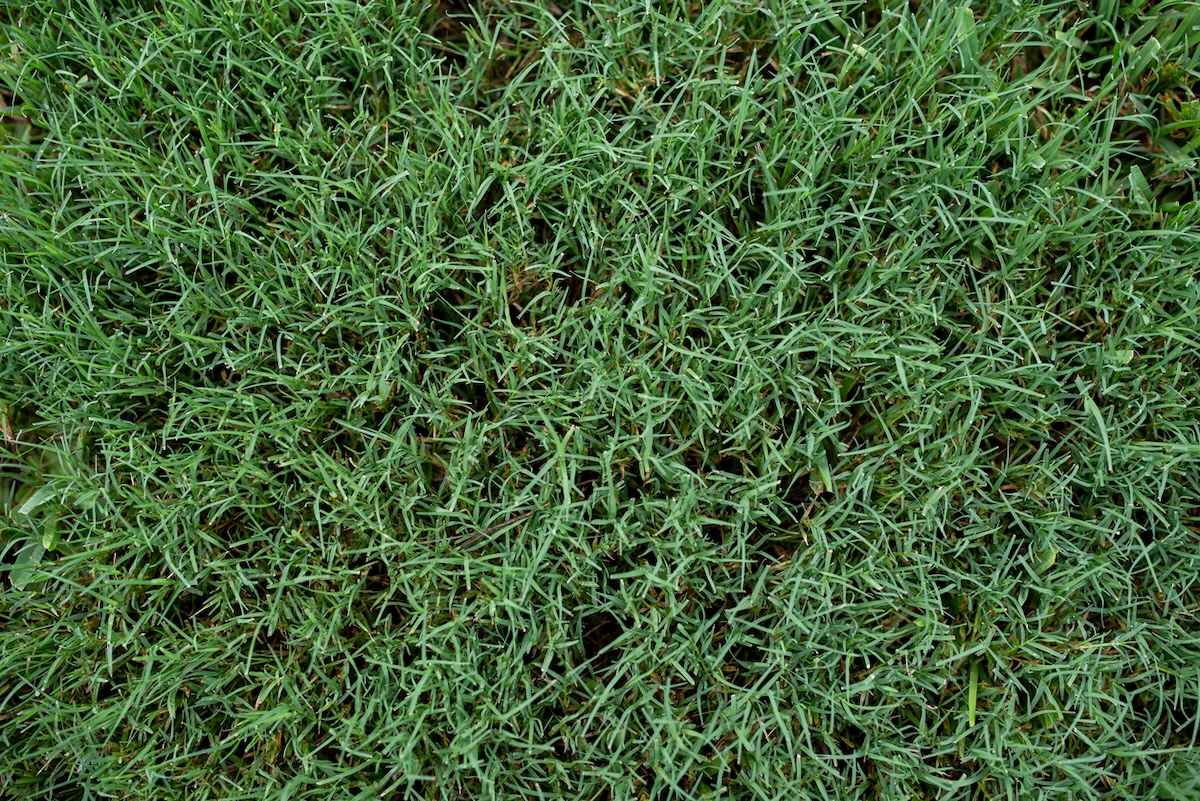
- Bermuda grass (pictured above), known for its dense, dark green blades, is touted as the most drought-resistant warm-season grass. “Bermuda grass [is] resilient and drought-tolerant,” says Musto. A low water user, Bermuda grass needs only 1 to 1.25 inches of water weekly from rainfall or irrigation to stay green. Whatever water it does receive, it uses efficiently, because its roots, which can extend as far down as 6 feet, can take up water from deep within the ground. After an extended drought of around 50 days, Bermuda grass can also go dormant for up to 3 to 4 weeks without dying, which allows it to recover its plush pile and vibrant color when watering is restored. The most drought-tolerant varieties of Bermuda grass include TexTurf and Celebration.
- Zoysia grass needs only 0.5 to 1 inch of water weekly to retain its thick, soft pile and light-to-medium-green color. It also has the ability to go dormant for 3 to 4 weeks without dying after an extended drought of around 30 days. Thanks to its far-reaching underground stems called rhizomes, zoysia grass (and Bermuda grass as well) can self-repair bare or drought-damaged turf. The most drought-resistant zoysia varieties are El Toro, JaMur, and Palisades.
- St. Augustine grass can endure drought conditions through its above-ground stems called stolons that help repair drought-damaged patches on the lawn. The coarse, light-to-dark-green grass also has minimal irrigation needs of 1 inch per week. After around 45 days of drought, Floratam, the most drought-hardy variety, can also go dormant for 3 to 4 weeks without dying.
The best drought-tolerant grasses in cool-season climates include tall fescue, fine fescue, and Kentucky bluegrass.
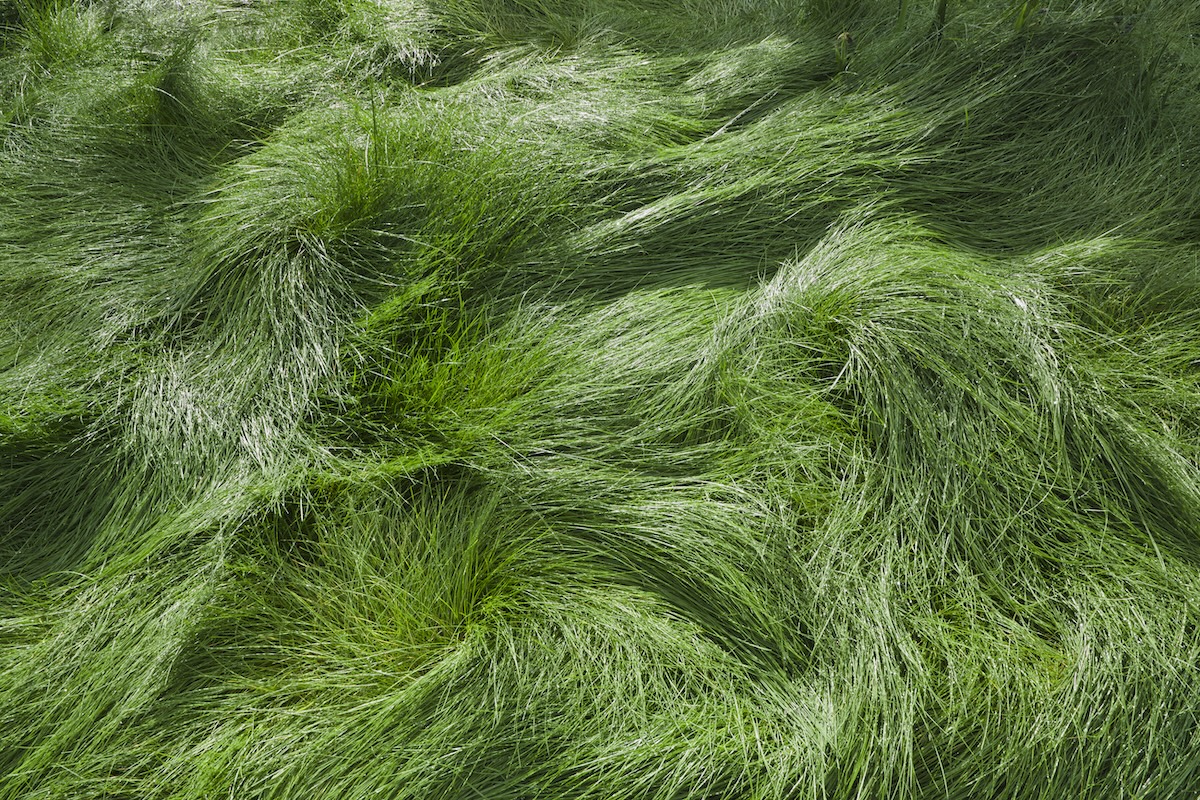
- Tall fescue (pictured above), a narrow-leaved, dark green grass, is among the best drought-resistant cool-season grasses thanks to its minimal irrigation needs of 1 to 1.25 inches of water per week. Its roots can grow between 2 to 3 feet long to access water deep in the soil, so it uses water efficiently. The dwarf-type varieties of tall fescue are among the most drought-tolerant. “Tall fescue is ideal for high-traffic areas that require a durable, wear-resistant grass with good drought tolerance,” says Bowers.
- Fine fescue’s drought resistance can be attributed to its low watering requirements, as little as 0.75 to 1 inch of water weekly, and underground rhizomes that can help repair drought-damaged grass to restore its thin, deep green blades. “Fine fescue is perfect for shaded areas and low-maintenance lawns,” says Bowers. Creeping Red and Chewings are the most drought-resistant varieties.
- Kentucky bluegrass needs 1 to 1.5 inches of water weekly to retain the characteristic bright green to blue-green color of its flat, narrow, or folded leaves. But its underground rhizomes can effectively repair drought-damaged turf to recover its color. Huntsville is among the most drought-tolerant of Kentucky bluegrass varieties.
Build a drought-resistant lawn by planting in the appropriate growing season and minimizing other sources of stress to your lawn.
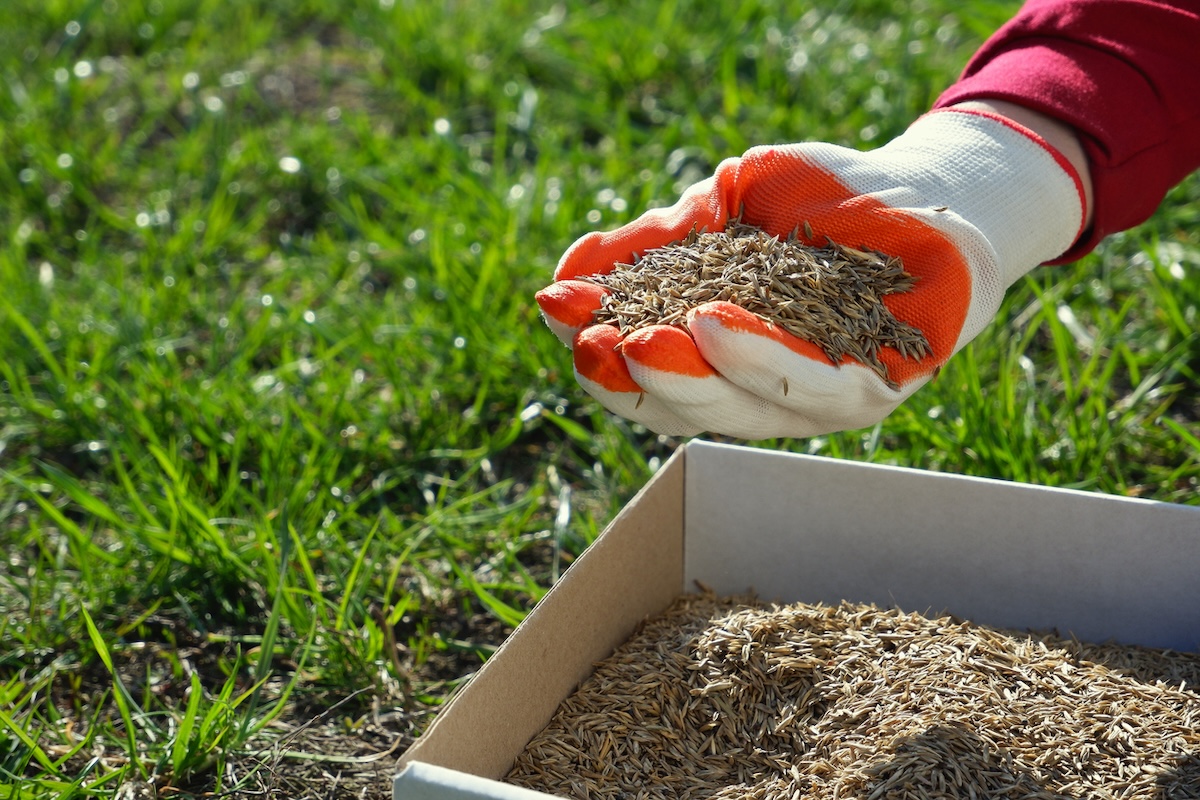
Plant cool-season grasses in early fall or spring and warm-season grasses in early summer or spring to ensure faster seed germination. During dry spells, use the tips below to maintain the health of your drought-resistant grass. If it’s too late in the season to plant drought-tolerant grass seed, or you don’t have the time or desire to reseed your existing lawn, you can also enlist these techniques to make a traditional turf more tolerant of dry conditions:
- Mow minimally. Because mower blades can put additional stress on already drought-damaged turf, mow less often—maybe every 10 to 14 days—during a drought, cutting no more than one-third of the height of the grass each time. Be sure to use sharp blades, as dull ones can lead to jagged grass that can easily dry out. Mow only when the soil is dry to avoid soil compaction, which reduces water uptake in the grass. “Mow your grass higher, around 3 to 4 inches, to shade the soil and reduce water loss,” says Bowers.
- After mowing, leave grass clippings on the turf, but no more than 0.5 inches thick. They act “as natural mulch to retain moisture and supply nutrients,” Bower says.
- Keep pets and kids off a drought-stressed lawn, as the weight of foot traffic can increase soil compaction.
- Bower suggests keeping your lawn free of weeds that compete for water and nutrients.
- Aerate your lawn biannually to improve water penetration into the roots and encourage healthy grass growth.
- Water grass regularly and deeply during a drought, usually at least every 7 to 10 days, each time watering until the top 6 to 8 inches of soil is wet. “Focus on deep and infrequent watering, providing about 1 inch of water per week in one or two sessions, and watering early in the morning to minimize evaporation,” says Bowers.
- Plunge a screwdriver into the soil to help you assess approximately how deeply you watered.
- If you’re under tight watering restrictions and planted a turfgrass like Bermuda grass that has a strong ability to go dormant, water only high-priority areas of the lawn, such as grass near flower beds in the front yard, and let other areas go dormant, to keep the lawn looking beautiful while conserving water.
Final Thoughts

To improve the drought tolerance of your lawn, you can start from scratch, building an entirely new lawn; reseed your current lawn with the best grass seeds for drought tolerance; or simply care for your current lawn, keeping restricted water availability in mind. Be sure to understand your climate and the types of grass that work best in your region.
FAQs
“You can enhance your lawn’s drought tolerance by overseeding it with drought-tolerant grass seeds,” says Bowers. “The best time for overseeding in cool-season climates is early fall or spring, while for warm-season grasses, late spring to early summer is ideal,” Musto advises. “Ensure thorough soil preparation and good seed-to-soil contact to maximize success,” he adds. Before applying drought-resistant grass seed, Bower suggests mowing your existing lawn shorter than usual and removing the clippings.
While Kentucky bluegrass and fescue grasses stand beautifully up to dry conditions, they also do well in wet areas. Ryegrass, too, is good for wet conditions and is a good grass seed for the northeast.
